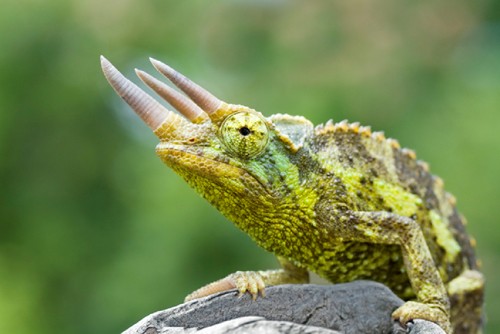Jackson’s or Three-horned chameleon (Chamaeleo jacksoni xantholophus)
Natural history
Jackson’s chameleons comprise three distinct subspecies native to the montane regions of Kenya. Large feral populations are found in Hawaii where specimens are often caught for the pet trade. Small numbers are also captive-bred.
Taxonomy
Class: Reptilia
Order: Squamata
Family: Chamaeleonidae
Color and Size
Adults may reach 12-15 in (30.5-38.1cm) in total (snout to tail) length, with a body length of about 5 in (12.7 cm).
Adults can reach 0.9-1.8 kg but most weigh less.
Diet
- Feed a variety of gut-loaded insects such as crickets, mealworms, grasshoppers, roaches, superworms, silkworms, and wax worms as well as pesticide-free snails, slugs, caterpillars, sowbugs, spiders, and flies of appropriate size.
- Dust the adult non-breeding diet with a calcium carbonate or calcium gluconate supplement once weekly. Calcium supplements should be devoid or low in phosphorus with a minimum Ca:P ratio of 2:1. Avoid products containing high levels of Vitamin D as this can lead to toxicity.
- A general vitamin/mineral supplement may be offered once weekly. Jackson’s chameleon may also be more sensitive to over-supplementation of vitamin A than some other lizards so use caution.
- For more information, download the client handout: Feeding Insect Eating Reptiles
Husbandry
| Temperature | Maintain a temperature gradient of 70-80°F (21-27°C) with a basking spot that reaches 82-85°F (28-29°C). Never maintain a Jackson’s chameleon above 84°F (29°C) for long periods of time. Provide a drop in temperature at night that ranges from 55°F to the low to mid 70s (13-24°C). |
| Humidity/water | Maintain 60-100% relative humidity. Jackson’s chameleons only drink water droplets from leaves and other surfaces. Offer water either by misting the plants every 4-8 hours or with an automatic watering system. Use of a cool-mist humidifier may also be necessary. |
| Cage size and design | House adults in a large, vertical wire enclosure. Plastic-coated wire-welded mesh enclosures serve well. The minimum cage size for an adult pair is 2 x 2 x 3 ft (0.6 x 0.6 x 0.9 m). |
| Cage furniture/supplies | Provide multiple branches or twigs for climbing, potted plants (e.g. Ficus benjamina or hibiscus) to provide visual security, and a full-spectrum light source for normal absorption of dietary calcium. |
| Social structure | May be housed as a mixed pair or one male may coexist with one or two females in a large cage with many visual barriers. |
Lifespan
3-8+ years
Chameleons typically reach sexual maturity between 6-9 months of age.
Anatomy/ physiology
| Dermatologic: | Some chameleon species, including the Jackson’s chameleon, have “chromatophores” or specialized cells in the skin that allow color change. |
| Respiratory: | Lizards have incomplete tracheal rings. |
| Musculoskeletal: | Chameleons are didactyl: five toes are fused into groups of two laterally and three medially giving the foot a mitten-like appearance. |
| Gastrointestinal: | The tongue is a complicated structure that sits within a structure at the base of the oral cavity. The tip of the tongue is normally darker where the taste buds are found. |
| Acrodont dentition: | Teeth are not set in sockets, but instead are weakly attached to the jawbone surface. |
| Ophthalmic: | The upper and lower eyelids are fused with only a pinhole opening for the pupil. The eyes can rotate and focus separately. |
| Urogenital: | A renal portal system is present. Like many lizards, the chameleon has a thin-walled bladder. The male copulatory organ is the hemipenes. |
| Sexual dimorphism: | Males have three distinctive rostral horns and a parietal crest. |
Restraint
Chameleons are most comfortable when allowed to perch on a wooden dowel or finger. When manual restraint is necessary, place one hand underneath to allow the chameleon to grip with its feet. Place the palm of your other hand over the chameleon’s back. Grasp the head behind the eyes with the thumb and index finger.
Venipuncture
(The ventral abdominal vein is not easily found).
Preventive medicine
Regular physical examination
Fecal parasite testing
Use ivermectin with caution; toxicity has been reported. Avoid use in debilitated animals.
Important medical conditions
The Jackson’s chameleon is a relatively hardy species.
- Dehdyration from housing at high temperatures or failure to provide adequate drinking water as droplets.
- Egg binding
- Endoparasitism
- Nutritional secondary hyperparathyroidism or metabolic bone disease
- Ophthalmic disease
- Stomatitis, periodontal disease
**Login to view references**
References
References
Bartlett RD, Bartlett P, Griswold B. Reptiles, Amphibians, and Invertebrates: An Identification and Care Guide, 2nd ed. Hauppage, NY: Barron’s Educational Series; 2010.
Coke RL, Couillard NK. Ocular biology and diseases of Old World chameleons. Veterinary Clin North Am: Exot Anim Pract 5(2):275-85, 2002.
Ferguson G, Kalisch K, McKeown S. Chameleons: Care and Breeding of Jacksons, Panther, Veiled and Parsons. Advanced Vivarium Systems. 2007.
Manchen K . Jackson’s chameleons (Trioceros jacksonii) in captivity. Chameleons! Online E-Zine. Available at http://www.chameleonnews.com. Accessed February 20, 2011.
Nevarez J. Lizards. In: Mitchell MA, Tully TN (eds). Manual of Exotic Pet Practice. St. Louis: Saunders Elsevier; 2009. Pp. 164-206.
Szell Z, Sreter T, Varga I. Ivermectin toxicosis in a chameleon (Chamaeleo senegalensis) infected with Foleyella furcata. J Zoo Wildl Med 32(1):115-117, 2001.
Thomas CL, Artwohl JE, Pearl RK, Gardiner CH. Swollen eyelid associated with Foleyella sp infection in a chameleon. J Am Vet Med Assoc 209(5):972-973,1996.
Pollock C. Basic information sheet: Jackson’s chameleon. May 30, 2012. LafeberVet Web site. Available at https://lafeber.com/vet/basic-information-for-jacksons-or-three-horned-chameleon/
